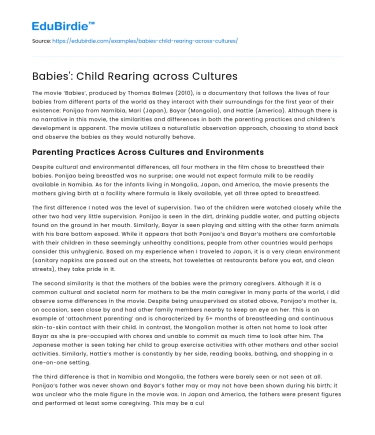The movie ‘Babies’, produced by Thomas Balmes (2010), is a documentary that follows the lives of four babies from different parts of the world as they interact with their surroundings for the first year of their existence: Ponijao from Namibia, Mari (Japan), Bayar (Mongolia), and Hattie (America). Although there is no narrative in this movie, the similarities and differences in both the parenting practices and children’s development is apparent. The movie utilizes a naturalistic observation approach, choosing to stand back and observe the babies as they would naturally behave.
Parenting Practices Across Cultures and Environments
Despite cultural and environmental differences, all four mothers in the film chose to breastfeed their babies. Ponijao being breastfed was no surprise; one would not expect formula milk to be readily available in Namibia. As for the infants living in Mongolia, Japan, and America, the movie presents the mothers giving birth at a facility where formula is likely available, yet all three opted to breastfeed.
Save your time!
We can take care of your essay
- Proper editing and formatting
- Free revision, title page, and bibliography
- Flexible prices and money-back guarantee
The first difference I noted was the level of supervision. Two of the children were watched closely while the other two had very little supervision. Ponijao is seen in the dirt, drinking puddle water, and putting objects found on the ground in her mouth. Similarly, Bayar is seen playing and sitting with the other farm animals with his bare bottom exposed. While it appears that both Ponijao’s and Bayar’s mothers are comfortable with their children in these seemingly unhealthy conditions, people from other countries would perhaps consider this unhygienic. Based on my experience when I traveled to Japan, it is a very clean environment (sanitary napkins are passed out on the streets, hot towelettes at restaurants before you eat, and clean streets), they take pride in it.
The second similarity is that the mothers of the babies were the primary caregivers. Although it is a common cultural and societal norm for mothers to be the main caregiver in many parts of the world, I did observe some differences in the movie. Despite being unsupervised as stated above, Ponijao’s mother is, on occasion, seen close by and had other family members nearby to keep an eye on her. This is an example of ‘attachment parenting’ and is characterized by 6+ months of breastfeeding and continuous skin-to-skin contact with their child. In contrast, the Mongolian mother is often not home to look after Bayar as she is pre-occupied with chores and unable to commit as much time to look after him. The Japanese mother is seen taking her child to group exercise activities with other mothers and other social activities. Similarly, Hattie’s mother is constantly by her side, reading books, bathing, and shopping in a one-on-one setting.
The third difference is that in Namibia and Mongolia, the fathers were barely seen or not seen at all. Ponijao’s father was never shown and Bayar’s father may or may not have been shown during his birth; it was unclear who the male figure in the movie was. In Japan and America, the fathers were present figures and performed at least some caregiving. This may be a cultural difference or a lifestyle difference, however I strongly suspect the former. Belsky (2016) mentions this as ‘variations in fathers’ involvement’, some fathers favor being involved in caregiving, while some value traditional roles of a man and woman.
Lastly, the third similarity I noticed throughout the movie was that the mothers were all teaching their babies the essentials they need to be well integrated into society. We hear Ponijao’s mother and Bayar’s mother syllable babbling, and Hattie is seen speaking ‘ma-ma’ and ‘pa-pa’. The film showed clips of the mothers helping their children learn how to walk with Ponijao’s mother holding her hand and Mari’s mother cautiously watching her.
Play Patterns
All babies play but their methods differ depending on the environment they were raised in coupled with their own unique personality. Ponijao is frequently seen with her mother and other children outside; her play pattern involves a lot of social interaction. Similarly, Mari’s mother often takes her to group activities with other mothers and their children and even cries when left to play alone with her toys. Contrasting this, Bayar is often left alone while his parents work, the movie capturing him happily playing by himself with a roll of toilet paper. As for Hattie, most of her scenes are with her parents but barely any notable interaction with other children. When her father took her to a group activity, she clearly wanted to leave indicating that she was used to spending most of her time with her parents. Nevertheless, all four reflects the concept of sensorimotor stage (0-2 years old) by Piaget’s Cognitive Theory which involves the baby utilizing and experimenting all their senses with their surroundings.
Reflection
The most challenging part of this assignment was to fully understand the different family situation, lifestyle, and their perspective and beliefs on child-rearing approaches given the interpretive nature of the movie. Overall, Ponijao and Bayar shared many similarities with each other, and Mari and Hattie also shared many similarities with each other. I believe this is greatly due to environmental and cultural differences between the two pairs as well as the resources available to each of the families. It is interesting to note that although the babies lived in different environments and were raised by different parenting styles, they all reached important milestones relatively around the same time.
References
- Balmès, T. (Director), Balmès, T. (Writer), & Chabat, A., Billot, A., & Rouxel, C. (Producers). (2010). Babies [Motion picture]. United States: Focus Features.
- Belsky, J. (2016). Experiencing the Lifespan. New York: Worth.






 Stuck on your essay?
Stuck on your essay?

